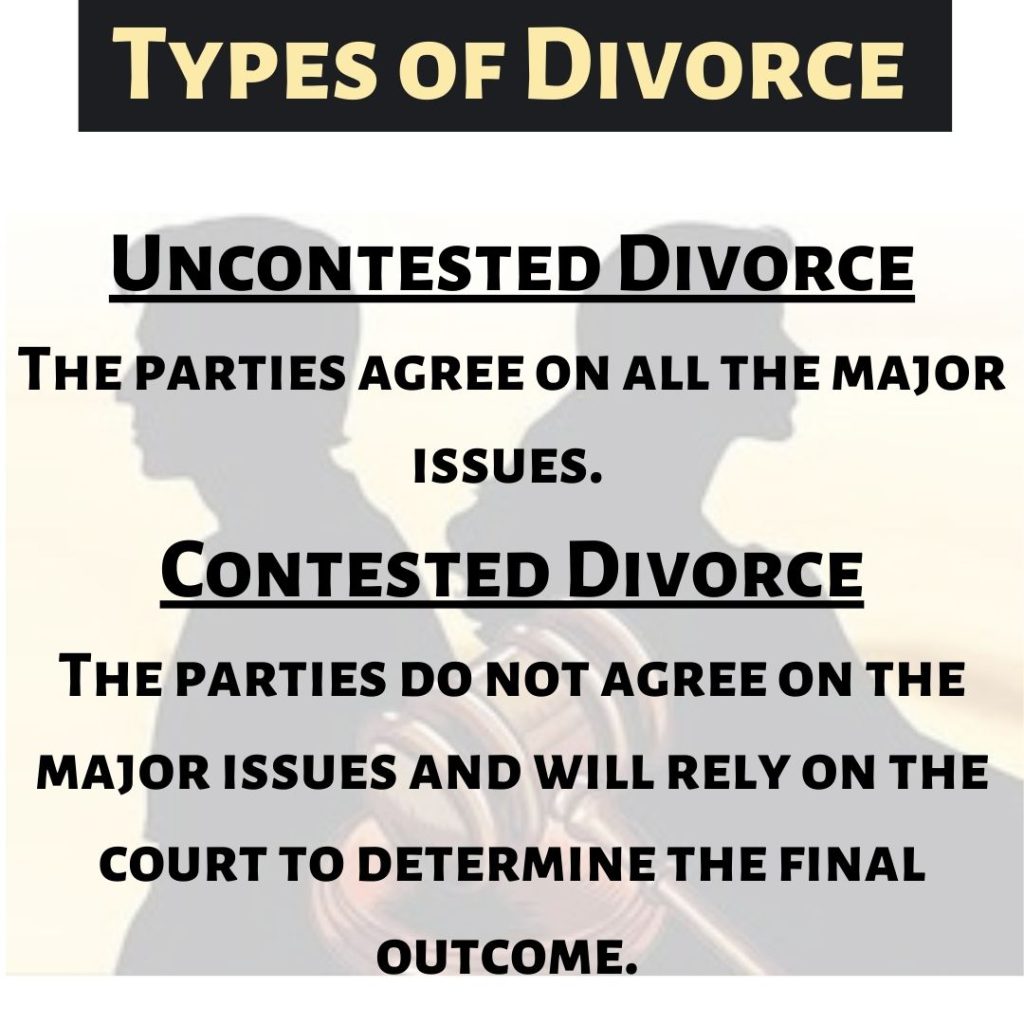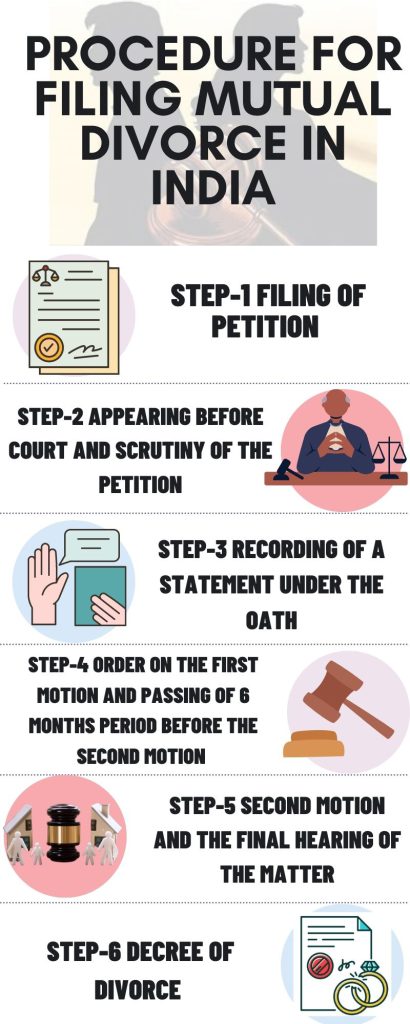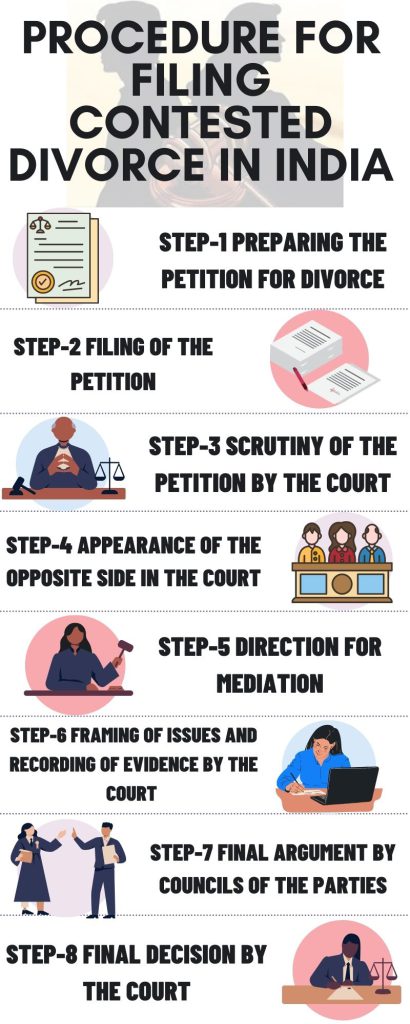Introduction
According to the reports, divorces have doubled over the past two decades.
So if you and your spouse have decided to legally part ways, this article is for you. It covers step-by-step procedures on how to file for a divorce in India.
A divorce is a traumatic experience to go through, however, with the right knowledge, you can make the process a little bit easier.
Let’s take a look at the process, the documents needed, the cost involved, the best lawyers for divorce, and the total time you will need for the entire process.
Keep Reading!
Suggested Reading: Aspects you must take care of before filing for divorce
Types of divorce

- Mutual (Uncontested)
Mutual divorce is governed under section 13-B of the Hindu Marriage Act.
A mutual or uncontested divorce is a type of divorce in which both the couples are pretty much sorted on grounds like
- Properties
- Assets
- Custody of kids
- Investments
- Alimony
In an uncontested divorce, there’s no fighting between couples for the above-listed things. The parties i.e the husband and the wife, mutually agree and proceed peacefully with the divorce.
- Contested
A contested divorce is exactly the opposite of an uncontested divorce. There’s a lot of tension between the couples during the entire procedure.
Section 13 of the Hindu Marriage Act, 1955 provides the grounds for filing a contested divorce, some of them are listed below
- The unsound mind of the partner
- Severe communicable disease
- Leprosy
- Haven’t heard of the partner for more than 7 years
- Desertion
- Cruelty
- Adultery
- Conversion of religion
Suggested Reading: Legal reasons for divorce in India
Difference between a contested and mutual consent (uncontested) divorce
Let’s see the difference between contested and uncontested divorce with the help of the table given below
| Mutual Consent Divorce | VS | Contested Divorce |
Section 13B of the Hindu Marriage Act 1955 | Section under which it is filed | Section 13 of the Hindu Marriage Act 1955 |
| Filed jointly by both the parties | Petition Filed | Filed only by one spouse since the other one may not have consent |
| No grounds required | Grounds on which it is filed | There are various grounds like- unsoundness of mind, desertion, leprosy, severe communicable disease, conversion of religion, cruelty, not being heard alive for many years, and adultery. |
| Mutual consent divorce is usually of short Duration | Time taken | Contested Divorce is usually time taking |
| A single or common lawyer hired by both the parties | Divorce lawyers hired | Both the parties have their separate lawyers |
| The husband and the wife decide on factors like alimony, custody of kids, investments, properties, assets, and all the belongings of both the partner | Decision Making | Lawyers mediate and argue on all the issues |
Suggested Reading: Difference between a contested and uncontested divorce
How to file for a divorce in India?
Procedure for filing a mutual or uncontested divorce in India

Mutual divorce comes under section 13 of the Hindu Marriage Act 1955. There is a set procedure to file for it, as given under this section. The procedure for filing a mutual divorce petition is explained below.
- Step-1 Filing of petition
The first step is to file a petition jointly by both the spouses in the family court. The petition should be filed on the grounds that the couple is living separately for one or more years or else stating that they are not able to live together and have mutually decided to dissolve the marriage. The petition should be filed by both spouses.
- Step-2 Appearing before court and scrutiny of the petition
After the filing of the petition, both the parties will have to appear before the court with their counsels. The court will scrutinize the petition and all the documents that are attached. The court may also try to reconcile the parties but if that’s not possible the divorce proceedings are started.
- Step-3 Recording of a statement under the oath
Once the court scrutinizes the documents and is fully satisfied, both the parties are called to record their statements under the oath.
- Step-4 Order on the first motion and passing of 6 months period before the second motion
After the statements are recorded, the order of the first motion is passed.
After this step, a period of 6 months is given before filing the second motion. The maximum period for filing a second motion is 18 months from the date of presentation of the divorce petition in the family court unless the petition is withdrawn in the meantime
- Step-5 Second motion and the final hearing of the matter
Once the period of 6 months is over and the couple still wants to go ahead with the divorce proceedings and file for a second motion, they can do so and proceed with the final hearing. In this step both the parties record their statement before the family court.
If the 2nd motion is not made within the period of 18 months, the court will not pass any decree for divorce. It is also a settled law that either party can withdraw their consent at any time before the passing of the decree.
- Step-6 Decree of divorce
In a mutual divorce, both parties have agreed on alimony, custody of kids, and other financial issues. If the court is satisfied by the hearing and if the court finds that the allegations are true and there is no chance of reconciliation then the court finally passes the decree of divorce declaring the marriage to be dissolved, based upon the facts and circumstances of the case. The divorce becomes final once the decree of divorce has been passed by the court.
Documents required for an uncontested divorce
Here are the documents that are required if you are going to file for a mutual divorce-
- Address proof of husband and wife
- Professional and Financial (present earnings) details of both husband and wife
- Marriage Certificate
- Information regarding family background
- Wedding photographs of the husband and wife
- Evidence that may prove that the husband and wife have not been living together for more than a year
- Evidence that can show failed attempts to reconcile
- Income Tax statements of both parties
- Property and asset details of husband and wife
Procedure for filing a contested divorce in India

Under the Hindu Marriage Act, a contested divorce can be filed based upon different grounds mentioned in the act. The process is very long and complicated. So the journey of the contested divorce starts by consulting a good divorce lawyer.
You will have to explain your entire case to your lawyer and then he/she can give you the best advice according to your case.
The procedure for filing a contested divorce is explained below.
- Step-1 Preparing the petition for divorce
Generally, in a contested divorce, the petition is filed by one of the spouses who has been aggrieved. The husband/wife seeking divorce will have to explain the reason and the circumstances under which he/she is taking divorce. The lawyer will then draft a petition based on facts that are explained by the petitioner. The Petition would have to be accompanied by relevant documents supporting the allegations as made in the petition. After it has been finalized, the petition along with affidavits and vakalatnama would be signed by the party contesting, in the presence of a Notary/commissioner.
- Step-2 Filing of the petition
After the petition is prepared and all formalities have been fulfilled, it would be filed before the appropriate family court according to the jurisdiction.
- Step-3 Scrutiny of the petition by the court
The court would scrutinize the petition and will hear the allegations from the lawyer filing the petition.
- Step-4 Appearance of the opposite side in the court
Once the court is satisfied with the petition and thinks the matter should move ahead, the court would issue a notice to be served upon the other party. After this, a copy of the petition and notice is sent to the other party, and on the next date of hearing, he/she should be present in the court with his/her lawyer. The opposite party would also have to file a reply to the divorce petition and any other application as the case may be.
- Step-5 Direction for mediation
The court at first will try to resolve the matter between the parties and ask them to appear for mediation. After the parties have appeared for the mediation in front of the mediator and in case no fruitful outcome is achieved, the court then proceeds with the divorce proceedings.
- Step-6 Framing of issues and recording of evidence by the court
The next step is that the court will proceed with the matter, frame the issues, and record the evidence. Both the parties will have to get cross-examined by the lawyers, and both the parties would be required to submit the pieces of evidence supporting their allegations. They may also have to produce supporting witnesses.
This step is the most crucial step of the entire proceedings. The entire fate of the case depends upon this step.
- Step-7 Final argument by councils of the parties
The above step is a time taking process. After this lengthy procedure is completed, the lawyer of each side would be required to present their arguments before the judge. Once the arguments are finished the court will decide a date on which it will pronounce its decision.
- Step-8 Final decision by the court
The court after hearing the entire proceedings decides the verdict. The verdict is based upon the facts and circumstances of each case.
If any party remains unsatisfied with the verdict, they can then challenge the decision in the higher court with the help of their lawyer. The limitation to filing for appeal is 3 months from the date of the order.
Documents required for a contested divorce
Several documents are required for a contested divorce. Here are a few important documents required to prove the ground upon which the divorce has been filed. Some of the essential documents have been listed below-
- Address proof of husband
- Address proof of wife
- Photographs of marriage between the husband and wife
- Certificate of marriage
- Evidence supporting the ground on which divorce is filed (cruelty, adultery, desertion, lunacy, leprosy, the presumption of death, conversion to another religion, etc.)
- Professional proofs
- Financial proofs
Cost involved
The court fee is nominal but the bulk is taken by the lawyers as their fees.
If you hire a private lawyer, their fees can vary from Rs 10,000 to Rs 1 lakh, depending on the type of divorce and duration involved.
However, don’t worry if you cannot afford the lawyer’s fees, you can also avail free legal services by getting an advocate from the legal aid cell
free legal services by getting an advocate from the legal aid cell.
Advocates can charge on the basis of each hearing or as a lump sum on an annual basis. Women can also ask for litigation expenses from husbands via court, but the amount granted by the court is usually less.
Suggested reading: How to avoid paying alimony
The time period required to get a divorce decree
In a mutual divorce, the process usually takes 18 to 24 months. However, no petition can be submitted before the marriage has completed one year.
Firstly the first motion will be filed and then the court will ask the parties to wait for 6 months before the second motion can be filed. and the court will award the divorce decree.
However, in a contested divorce, the process may take time as both the parties had not agreed on many points and it will take time to come to a settlement. So a contested divorce can take 3-5 years because the nature of these kinds of cases are complicated and further if any party remains unsatisfied with the judgment they can move to the high court or supreme court and challenge the judgment of the lower court.
Suggested reading: Reasons for divorce in India
Conclusion
The entire process of taking a divorce is very emotionally and mentally devastating. However, taking the help of a good and experienced divorce lawyer can save you from a lot of mental stress. They can help you to bring the maximum benefits through their experience.
I hope this article would have been of some help to you.
For further queries regarding divorce or divorce lawyer or anything related to divorce, visit our website.

Great guide on filing for divorce in India! Your clear, step-by-step approach makes a complex process much more understandable. Thanks!